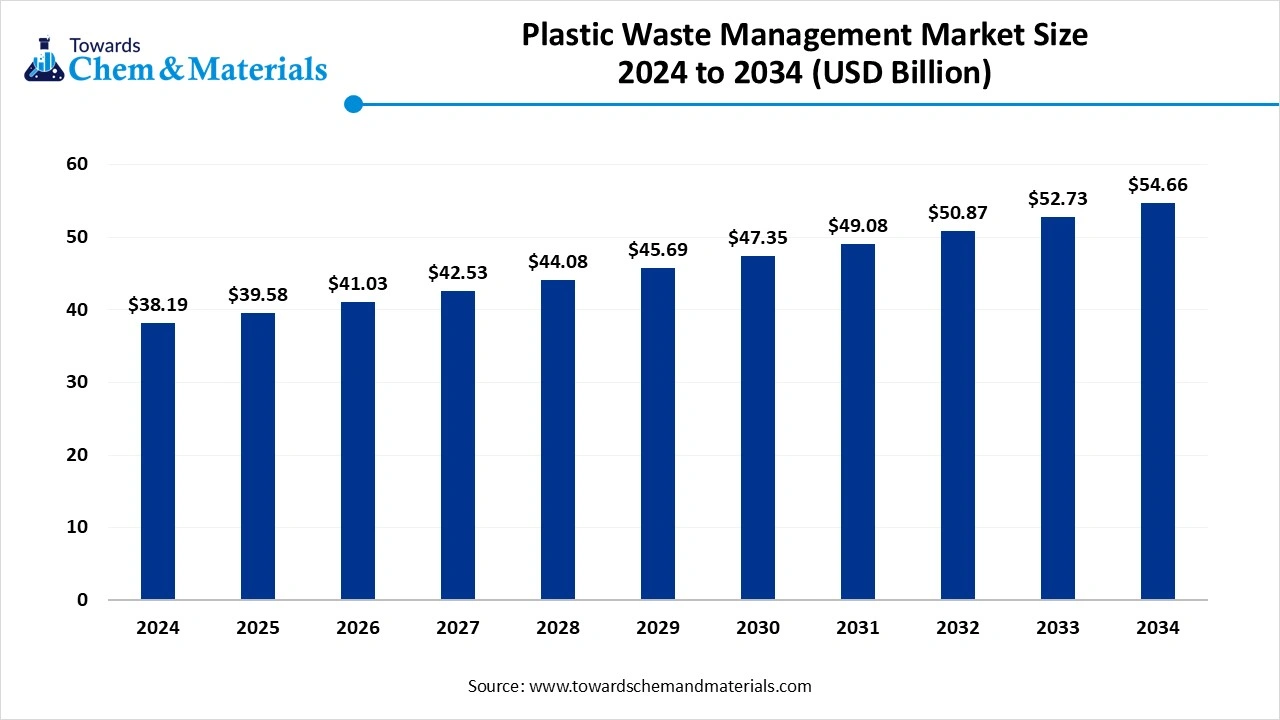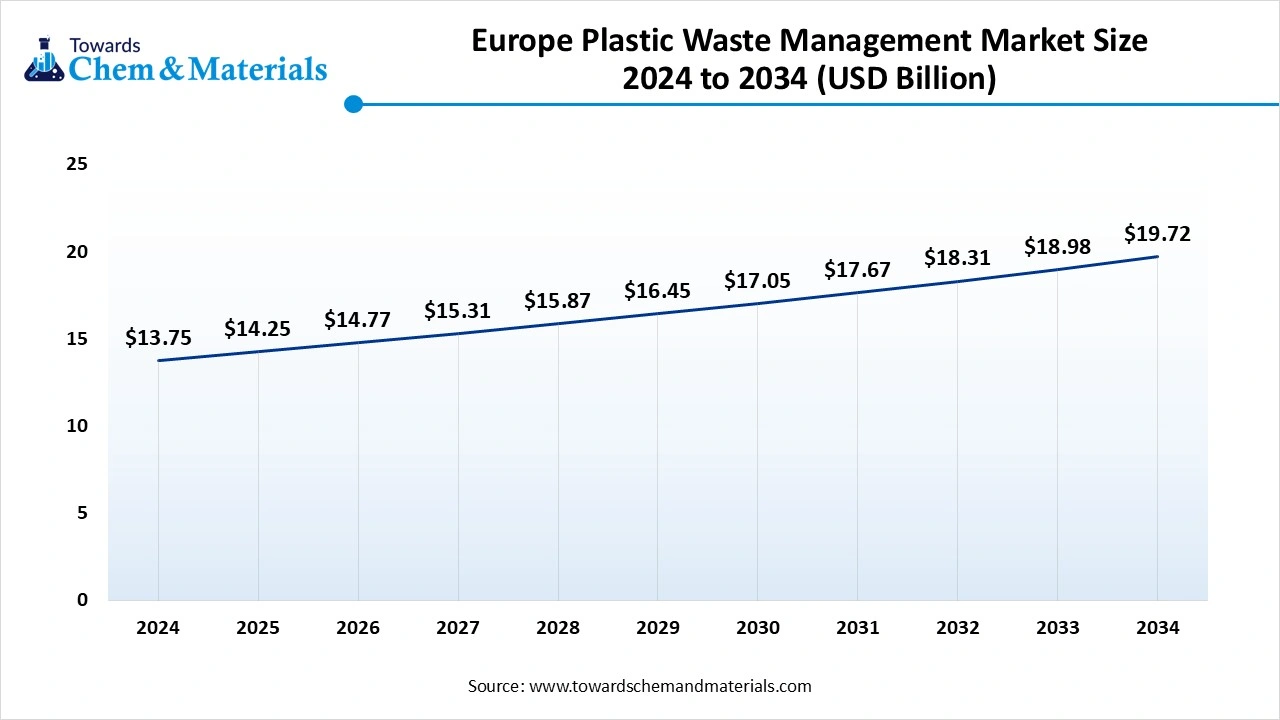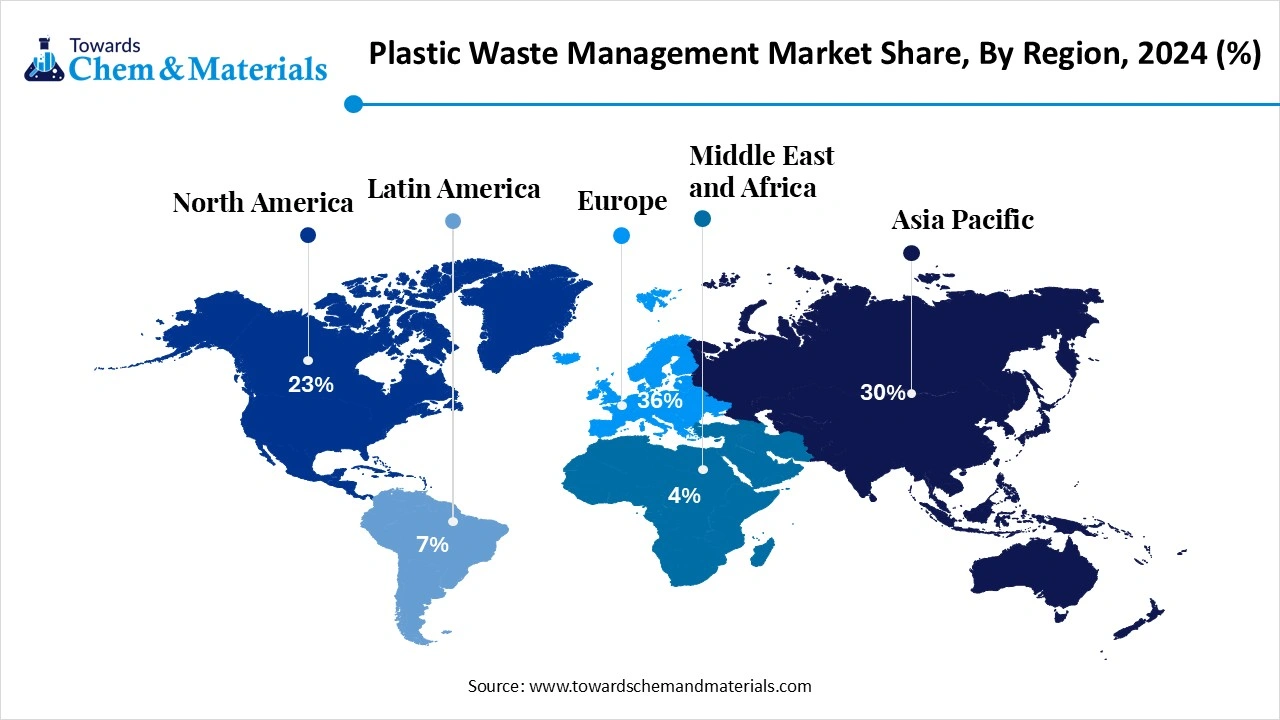December 2025
The global plastic waste management market size was reached at USD 38.19 Billion in 2024 and is expected to be worth around USD 54.66 billion by 2034, growing at a compound annual growth rate (CAGR) of 3.65% over the forecast period 2025 to 2034. The growth of the market is driven by the growing environmental significance, like the management of pollution and sustainable development through recycling and waste management.

The plastic waste management market is significant because it provides critical solutions to plastic pollution, protecting environmental and human health by reducing waste in landfills and oceans. This market drives economic benefits through resource and energy savings from recycling, spurs innovation in waste-to-energy and biodegradable materials, and fosters growth in sectors like packaging and consumer goods by promoting circular economy principles.
| Report Attributes | Details |
| Market Size in 2025 | USD 39.58 Billion |
| Expected Size by 2034 | USD 54.66 Billion |
| Growth Rate from 2025 to 2034 | CAGR 3.65% |
| Base Year of Estimation | 2024 |
| Forecast Period | 2025 - 2034 |
| Dominant Region | Europe |
| Segment Covered | By Service Type, By Treatment Method, By Polymer Type, By Source, By Sorting Technology, By End Use of Recovered Plastics, By Region |
| Key Companies Profiled | Remondis , Biffa , Indorama Ventures , LyondellBasell , Eastman , Tomra , ALPLA , Plastipak , KW Plastics , MBA Polymers |
Key technological shifts are transforming the plastic waste management market through advancements in advanced recycling, digitalization, and new plastic alternatives. These innovations are enabling a more circular economy by improving sorting efficiency, broadening the range of recyclable materials, and introducing viable, sustainable options, which increase the opportunity for the growth of the market.
| Region / Country | Regulatory Body | Key Regulations / Frameworks | Focus Areas | Notable Notes |
| United States | U.S. Environmental Protection Agency (EPA), Department of Energy (DOE), State-Level Agencies (e.g., CalRecycle, NYDEC) | - Save Our Seas 2.0 Act (2020) - Resource Conservation and Recovery Act (RCRA) - Break Free From Plastic Pollution Act (proposed) |
- Circular economy and recycling initiatives - Extended producer responsibility (EPR) at the state level - Single-use plastic bans in various states |
No unified federal plastic law; several states (California, New York, Oregon) lead in EPR and plastic bans. The U.S. EPA promotes the National Recycling Strategy (2021) for a 50% recycling rate by 2030. |
| European Union | European Commission (DG ENV), European Chemicals Agency (ECHA) | - EU Single-Use Plastics Directive (EU 2019/904) - Waste Framework Directive (2008/98/EC) - Packaging and Packaging Waste Regulation (PPWR, under revision) |
- Extended producer responsibility (EPR) - Design for recyclability - Plastic packaging reduction targets |
The EU has the most comprehensive plastic regulatory system. Member states enforce bans on single-use plastics and require 90% collection of plastic bottles by 2029 under the SUP Directive. |
| China | Ministry of Ecology and Environment (MEE), National Development and Reform Commission (NDRC) | - Plastic Pollution Control Regulation (2020) - Solid Waste Pollution Prevention and Control Law (amended 2020) |
- Ban on non-degradable plastics - Import restrictions on plastic waste - Promotion of biodegradable materials |
China’s “National Sword Policy” (2018) reshaped global recycling flows. Nationwide bans on non-degradable plastics are being phased in through 2025. |
| India | Ministry of Environment, Forest and Climate Change (MoEFCC), Central Pollution Control Board (CPCB) | - Plastic Waste Management Rules, 2016 (amended 2022) - Extended Producer Responsibility (EPR) Guidelines, 2022 |
- Producer responsibility and recycling traceability - Single-use plastic ban (effective July 2022) - Waste segregation and labeling |
India’s framework mandates traceable EPR compliance via a digital portal. Producers must meet annual recycling targets. Strong emphasis on collection networks and municipal coordination. |
| Japan | Ministry of the Environment (MOE), METI | - Plastic Resource Circulation Act (2022) - Container and Packaging Recycling Law (1995; revised 2020) |
- Eco-design and recyclability - Corporate waste management plans - Product labeling and traceability |
Japan emphasizes corporate responsibility and circular design. The 2022 Act mandates eco-friendly material selection and reuse planning by manufacturers. |
| Middle East (UAE, Saudi Arabia) | Environment Agency – Abu Dhabi (EAD), Saudi Standards, Metrology and Quality Organization (SASO) | - UAE Federal Law No. 12 (2018) on Waste Management - SASO Technical Regulation for Biodegradable Plastics (2020) |
- Biodegradable packaging mandates - Waste segregation and landfill diversion |
GCC countries are adopting bio-based plastic certification and recycling investment programs to meet Vision 2030 sustainability goals. |
How did the Collection and Transportation Segment dominate the Plastic Waste Management Market in 2024?
The collection and transportation segment dominated the market with a share of 36% in 2024. This segment forms the foundation of plastic waste management, involving organized collection, sorting, and transfer of plastic waste from residential, industrial, and commercial areas to recycling or disposal facilities. Governments and private companies are increasingly investing in logistics optimization and smart tracking systems to enhance operational efficiency. Growth in urban waste volumes and mandatory segregation policies are driving the demand for robust collection and transportation infrastructure across developing economies.
The chemical recycling segment expects significant growth in the plastic waste management market during the forecast period. Chemical recycling transforms complex or contaminated plastics into basic monomers or fuels using processes such as pyrolysis, depolymerization, or gasification. Unlike mechanical recycling, it can handle mixed or multi-layered waste streams, reducing landfill dependency. Rising focus on sustainability and technological advancements by major chemical firms like BASF and SABIC is expanding this segment. Its scalability and compatibility with existing refining systems make it a key innovation in the next generation of waste management technologies.
Which Treatment Method Segment Dominated The Plastic Waste Management Market In 2024?
The mechanical recycling segment dominated the market with a share of 43% in 2024. Mechanical recycling involves the physical processing of plastic waste through sorting, cleaning, shredding, melting, and remolding into new products. Investment in advanced sorting and washing equipment has improved the purity of recyclates. Mechanical recycling remains the most widely adopted treatment approach, particularly in packaging and consumer goods sectors where consistent polymer recovery is essential.
The chemical recycling segment expects significant growth in the plastic waste management market during the forecast period. This method breaks down polymers at the molecular level using heat or solvents, producing monomers that can be re-polymerized into high-quality plastics. The growing regulatory push for circular plastics and rising R&D investments in depolymerization and pyrolysis technologies are propelling this segment. Chemical recycling contributes significantly to achieving net-zero waste goals and complements existing mechanical recycling systems.
How Did The Polyethylene Segment Dominate The Plastic Waste Management Market In 2024?
The polyethylene segment dominated the market with a share of 39% in 2024. Polyethylene dominates global plastic consumption and recycling efforts, driven by its wide use in packaging films, bags, and containers. Both low-density (LDPE) and high-density (HDPE) variants are being recycled using advanced mechanical and chemical processes. Recycling PE reduces landfill pressure and carbon emissions while creating new applications in pipes, films, and household goods. The shift toward circular packaging initiatives by major brands is enhancing demand for recycled PE in sustainable manufacturing and packaging solutions.
The polypropylene segment expects significant growth in the plastic waste management market during the forecast period. Polypropylene is extensively used in automotive parts, fibers, and packaging due to its lightweight and chemical-resistant properties. Advanced sorting and compatibilization techniques are enhancing the recyclability of PP from mixed waste streams. Growing interest in post-consumer recycled PP by consumer goods manufacturers and stringent plastic waste regulations are further supporting this segment’s expansion.
Which Source Segment Dominated The Plastic Waste Management Market In 2024?
The residential segment dominated the market with a share of 45% in 2024. The residential sector contributes most of the plastic waste through single-use packaging, household products, and disposable plastics. Efficient curbside collection and public awareness programs are essential to increase segregation at the source. The growing trend toward responsible consumer behavior and government initiatives promoting extended producer responsibility (EPR) are improving the efficiency of residential waste recovery.
The commercial and institutional segment expects significant growth in the plastic waste management market during the forecast period. This segment includes waste generated from retail, hospitality, offices, and healthcare sectors. Commercial waste collection systems are usually better organized, enabling easier sorting and recycling. Institutional collaborations with waste recyclers and the introduction of corporate sustainability mandates are increasing demand for efficient plastic waste management solutions in this sector.
How did the Optical/ NIR-Based Automated Sorting Segment dominate the Plastic Waste Management Market in 2024?
The optical/NIR-based automated sorting segment dominated the market with a share of 41% in 2024. Optical and near-infrared (NIR) sorting systems use advanced sensors to identify plastics by color, polymer type, and composition. The adoption of these technologies in large-scale recycling facilities ensures efficient processing of mixed waste streams. The growing focus on digital waste tracking and AI-assisted optical sorting is further boosting efficiency in industrial-scale recycling operations.
The AI/robotics-enhanced sorting segment expects significant growth in the plastic waste management market during the forecast period. AI and robotics-enhanced systems integrate machine learning and robotic arms to identify, pick, and sort plastic waste with high accuracy. These systems adapt to varying contamination levels and evolving packaging materials. The integration of smart analytics and real-time monitoring makes AI-based sorting ideal for high-throughput recycling environments, ensuring consistency and precision in processed materials.
Which End Use Segment Dominated The Plastic Waste Management Market In 2024?
The packaging and bottles segment dominated the market with a share of 49% in 2024. Recycled plastics are widely used in producing bottles, films, and flexible packaging materials. The use of recycled PET and HDPE helps reduce dependence on virgin polymers and carbon emissions. Growth in e-commerce and changing consumer preferences toward eco-friendly packaging are further driving this segment’s demand.
The textiles and fibers segment expects significant growth in the plastic waste management market during the forecast period. The textiles and fibers segment uses recycled plastics, especially PET, to produce fabrics, carpets, and industrial textiles. With rising awareness of sustainable fashion, several apparel brands are adopting recycled fibers for clothing and accessories. The transformation of plastic waste into fiber applications demonstrates the material’s versatility and supports global efforts to reduce landfill accumulation and promote a circular textile economy.
Europe Plastic Waste Management Market Size, Industry Report 2034
The Europe plastic waste management market size was valued at USD 13.75 billion in 2024 and is expected to reach USD 19.72 billion by 2034, growing at a CAGR of 3.67% from 2025 to 2034. Europe dominated the market with a share of 36% in 2024.

Europe leads the global plastic waste management landscape due to stringent environmental regulations and a strong circular economy framework. Countries across the EU have adopted extended producer responsibility (EPR) laws, mandating high recycling rates. The region also emphasizes innovation in sustainable plastics and industrial-scale recovery of post-consumer and post-industrial waste, positioning Europe as a hub for high-efficiency recycling practices and eco-conscious consumer behavior.
UK Growth Is Driven By The Policies And Investments In The Market
The UK is rapidly advancing in plastic waste management through national recycling programs, infrastructure upgrades, and policy interventions. Emphasis on sorting technology, automated facilities, and chemical recycling is increasing recycling efficiency. Retailers and manufacturers are promoting recycled content in packaging, driven by consumer demand and regulatory targets. Public-private partnerships and investments in AI-based sorting, robotics, and sustainable materials further strengthen the UK market, positioning it as a significant contributor to the European recycling ecosystem.
Asia Pacific Has Seen Growth Driven By Increased Urbanization.
Asia Pacific is expected to have significant growth in the market in the forecast period. Asia Pacific is experiencing dynamic growth in plastic waste management due to increasing urbanization, industrialization, and plastic consumption. Mechanical and chemical recycling facilities are expanding, supported by government initiatives and private investments. Rising awareness of environmental sustainability, coupled with circular economy adoption, is driving regional demand for advanced sorting technologies, waste-to-resource solutions, and sustainable end-use applications in packaging and textiles.

India's Market Growth Is Driven By The Growing Industrial Demand, Which Fuels The Growth.
India’s plastic waste management market is growing rapidly due to urbanization, regulatory initiatives, and increasing industrial demand for recycled materials. The government’s push toward single-use plastic bans, EPR regulations, and infrastructure development is promoting collection and recycling efficiency. Mechanical and chemical recycling technologies are gaining traction, particularly for post-consumer PET, HDPE, and polypropylene. Public awareness campaigns, NGO interventions, and private sector participation are also driving innovation in waste collection, sorting, and sustainable end-use applications across packaging, textiles, and construction.
By Service Type
By Treatment Method
By Polymer Type
By Source
By Sorting Technology
By End Use of Recovered Plastics
By Region
Anticipated market trends show that, the global monochloroacetic acid market volume was estimated at 605.32 Kilo Tons in 2024 and is predicted to incr...
According to forecasts, The global ceramic membrane market size is calculated at USD 10.82 billion in 2024, grew to USD 11.94 billion in 2025 and is p...
December 2025
December 2025
December 2025
November 2025